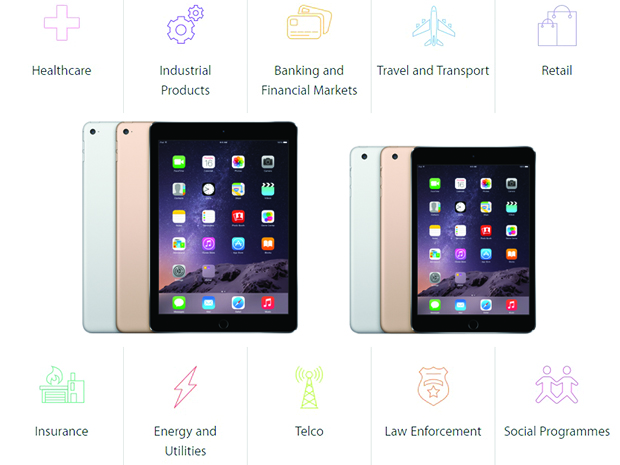iPad in the enterprise: How the tablet redefined Apple's enterprise journey


Apple's iPad has become an enterprise juggernaut. According to the most recent Good Technology Mobility Index Report, the iPad made up 81 percent of new enterprise tablet activations in Q1 2015. More impressive is that, of all the tablets in use in the enterprise a year ago, 92 percent were iPads.
Apple worked hard to make the iPad a machine that could be used by the average consumer, from toddlers to grandparents. But along the way, the iPad quickly became the go-to tablet for professionals. And, according to 451 Research's Boris Metodiev, that was likely an afterthought.
"I don't think that Apple initially envisioned that this could be a device used for enterprise uses," he said.
Whether an elaborate plan or a happy accident, the iPad took the enterprise market by storm and ultimately forced Apple to take a different look at market opportunities in business and education.
Van Baker, a vice president and research director for Gartner, said that the history of the iPad in the enterprise started with BYOD.
"The uses started with, mostly, employees bringing them in, using their personal products to do basic productivity kinds of things like get to email, get to calendar and contacts, that kind of stuff," Baker said.
Then, they began to extend use with licenses for other services and with apps optimized for the iPad's larger screen. Third-party apps for common enterprise activities such as expense tracking and project management helped professionals get even more out of their iPads.
From that initial penetration through personal use, it gave the enterprise a deeper awareness of tablet technology, Baker said. Then, enterprises began to see how they could integrate iPads with their workforce by developing role-specific applications for specific use cases.
"In some instances because it was less expensive than using a PC, in some cases because it was more functional than a smartphone because of the screen real estate," Baker said.
The iPhone may have signaled the start of Apple's mobile journey, but the iPad became the bridge by which the Apple ecosystem crossed over into the enterprise market. Once the iPad became a fixture, it was easier for organizations to justify iPhone deployments, especially as they phased out legacy devices like BlackBerry and Windows Mobile. In some cases, it even opened the door to supporting MacBooks and iMacs.
Apple's success with the iPad in the enterprise is multifaceted, but there are a few aspects that stick out. One is that Apple has a built-in fanbase.
"If they see that Apple is doing something new, if they see that Apple is really making an effort in the enterprise, they will just follow," Metodiev said. "It is an inspirational brand name."
Another factor is that many developers consider it easier to write applications for iOS, because the closed ecosystem means that iOS devices aren't dealing with the same kind of fragmentation that Android faces.
The main reason that Baker cites as the driver of the iPad's success is the belief that the iOS platform is a more secure platform than Android.
"The Android devices didn't have the kinds of things that enterprises were looking for in terms of being able to deploy and manage enterprise applications," Baker said. "They didn't have the security controls, they were a rootable product. Android has begun to address a lot of that in recent months, but that's a fairly new effort."
It's more about the platform than it is about the hardware. There's not a hardware feature that will give any Android tablet or the iPad a foothold over the competition. Once Apple saw the momentum in the enterprise, it quickly moved to provide the platform features that the enterprise needed. That included things like remote wipe, remote lock, and containerized deployments of apps.
However, as enterprises consider an iPad deployment, Baker said it is essential to understand the benefits and the limitations of the platform.
"It's not a PC replacement. It's not a general-purpose computer," Baker said. "It needs to have apps that are unique to it."
The iPad is not, necessarily, a good platform for virtualized desktop applications that are running on Windows -- although it can be used for that. The iPad shines as an application vehicle and a machine that can handle repetitive processes with a few straightforward steps.
Of course, functionality is a problem shared by all tablets. Tablets typically do not have a keyboard or mouse and that's a problem for many enterprise users. Metodiev said that this is something that Apple could remedy with the rumored iPad Pro or iPad+. Releasing an official detachable keyboard similar to the Microsoft Surface, and using Force Touch to simulate a mouse could add to the iPad's appeal for professionals.
Other ways that Apple could make a new iPad model better suited for the enterprise, Metodiev said, would be to give the device a larger screen, longer battery life, and better multitasking.
Looking ahead, Baker said that there's still a lot of headroom for tablets in general -- both Android and iOS. Google is working hard to make Android more enterprise-friendly with the introduction of Android for Work and changes to the core Android OS to make it more manageable and secure. Because of this, competition in the enterprise tablet market should continue to heat up.
The dark horse in that competition is Microsoft. With Windows 10, it wants to merge the Windows experience across platforms and make it a more continuous experience. It may be too early to tell, but that could pose another threat to the iPad.
"If Microsoft can make it work, the implications are huge," Metodiev said.
Since consumer demand for tablets has waned in recent years, Apple's enterprise focus has become key in keeping the iPad successful. Expect that trend to continue.